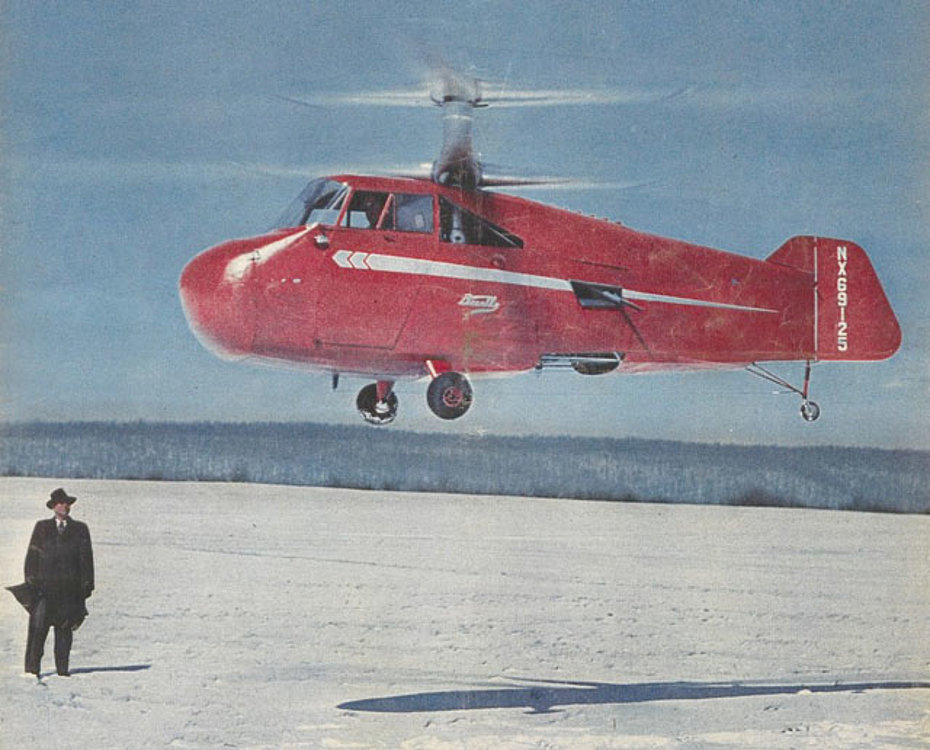
Brantly B-2 - History and technical description
Some historical notes
Newby Odell Brantly (1905-1993) was a brilliant American inventor. His interests ranged in many fields including aviation. Among his inventions there are a pump jack, several white goods, an engine for bicycles and one for airplanes, printers for the paper industry, a mechanical digger, a bra for athletes and various knitting machines developed for the Pennsylvania Elastic Company, an American company widely known in the past with subsidiaries in Australia, New Zealand, England and Germany, all active in the production of elastic products. During 1943, while travelling for this large manufacturer, Brantly started to work on the project of a helicopter inspired by the early Sikorsky models. As many others he was convinced that the civil helicopter would have a brilliant future in the post-war period.
The war, the lack of materials and mechanical parts delayed the completion of his first prototype designated Brantly B-1 (registered NX-69125), a two-seater with two coaxial rotors powered by a 112/150 kW/hp Franklin O-335 engine. Despite the success of the test flights, which started in 1946 in Berwyn (Pennsylvania), this model never went into production. The B-1 proved to be too complex for the personal type helicopter Mr. Brantly wished to build, however it served as a valuable test bed.
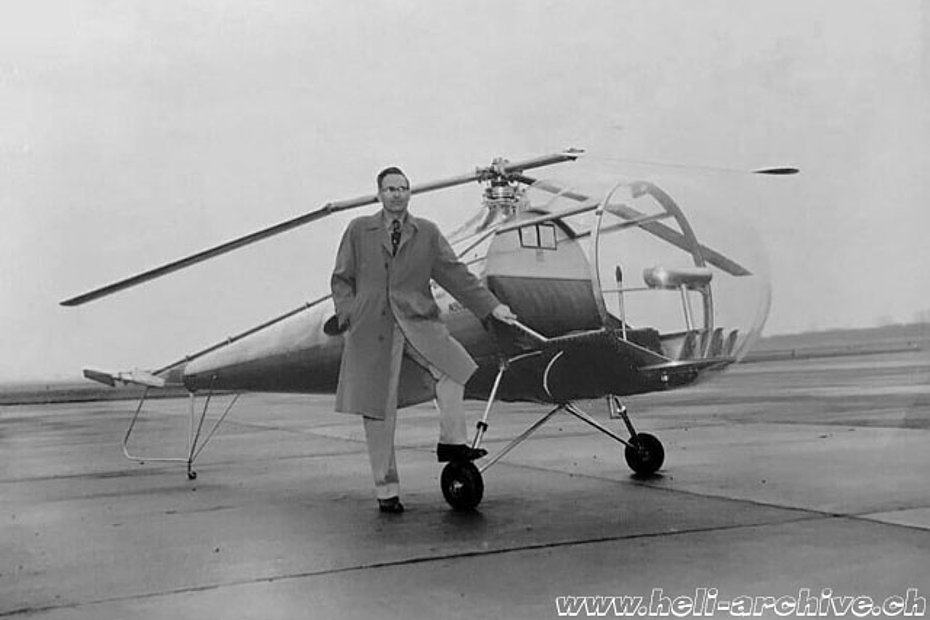
For this reason he designed a new model with a conventional configuration (main and tail rotor) using the B-1 rotor design. Simpler, lighter and more economical the second prototype was designated B-2. One of the initial problems to solve when this prototype was designed was the lack of an adequate engine. That is why at the beginning the B-2 was powered with a 100/135 kW/hp Lycoming O-290-D2. Much later the prototype was equipped with a more powerful Lycoming VO-340-A1A (derived from the model O-320) which was originally developed by the homonym builder for the TEMCO-Riley D-16A Twin Navion airplane.
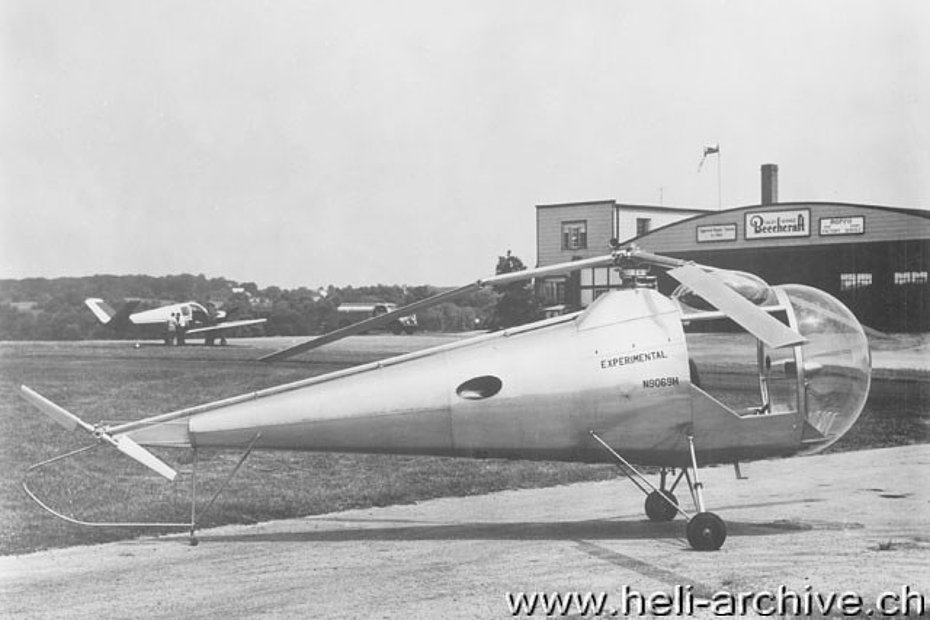
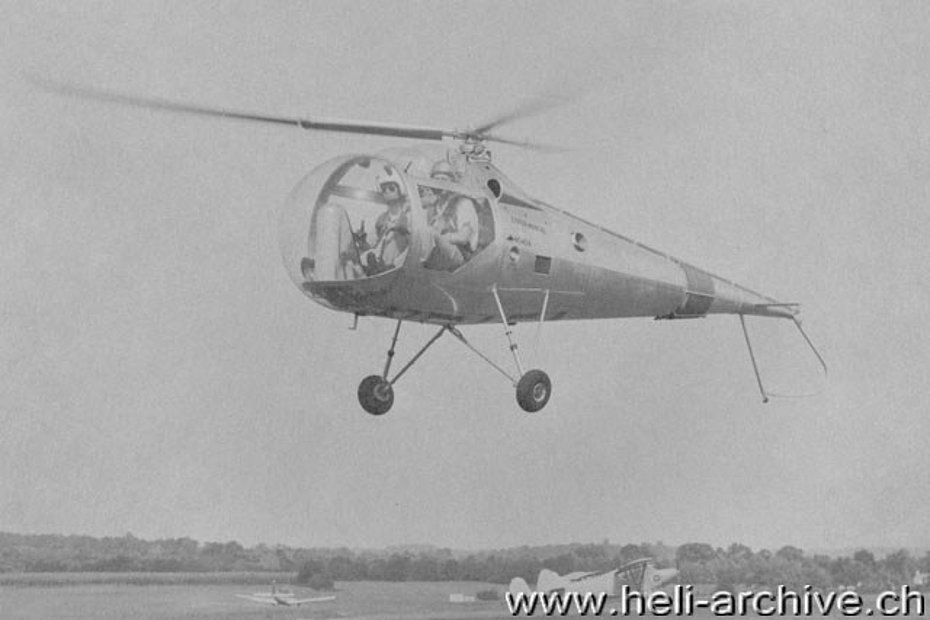
The first prototype of the Brantly B-2 received the registration N9069H and did its first flight on the 21st of February 1953 piloted by captain Frank A. Erickson, the famous US Coast Guard pilot who pioneered the use of the helicopter in the USCG during WWII. From that date on the helicopter made a long series of test flights which culminated years later with its certification. On the 15th of December of the same year the Brantly Helicopter Corporation was founded in Philadelphia (Pennsylvania). The second prototype registered N545A started its test flight on the 14th of August 1956. In November it was tested by some military pilots of the Naval Air Test Center of Patuxent River (Maryland) and others of Furt Rucker (Alabama).
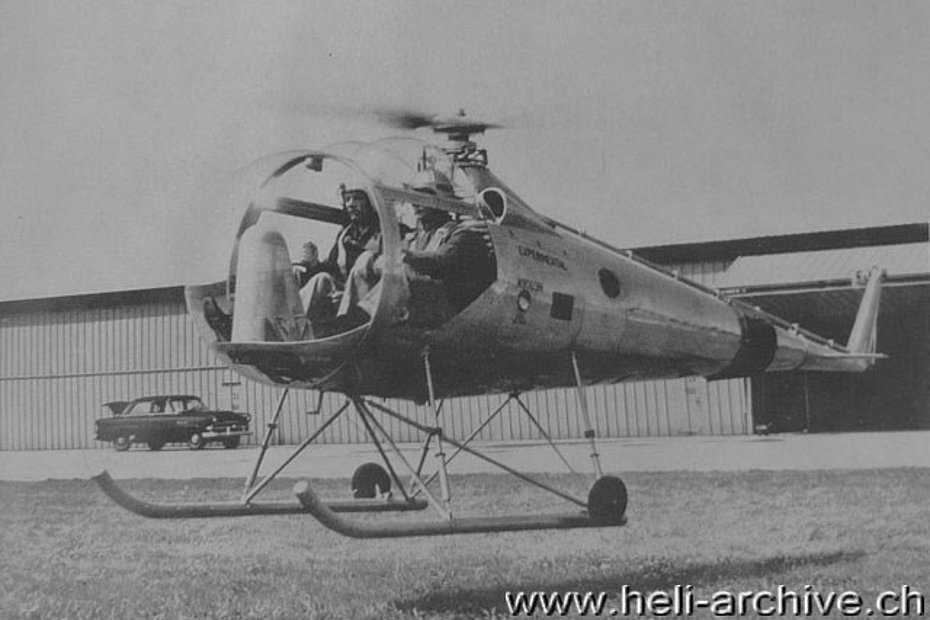
That year Brantly decided to transfer his facility to Frederick (Oklahoma), even if he continued to work for a while with a small group of technicians in his office of Philadelphia. In January 1957 the new plant was officially inaugurated with an open-house day for the citizens of Frederick. After the military evaluations Brantly decided to introduce a series of modifications on the N9069H.
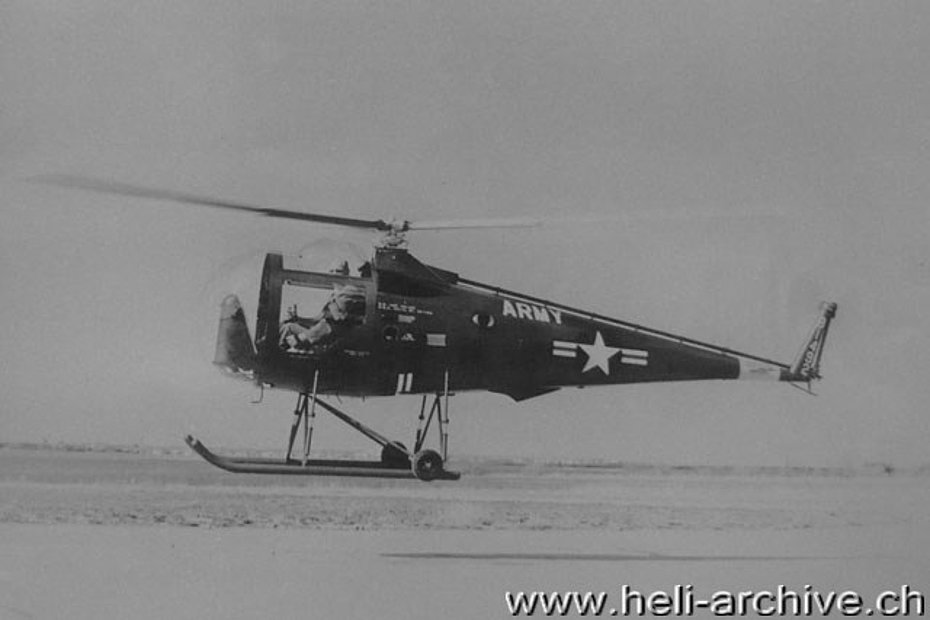
Some were quite evident as for example the new skid landing gear (instead of the original one which consisted of two main wheels in the front and a small wheel to support the tail) and a raised tail rotor. The cooling system of the engine oil, originally provided by an external cooling coil of finned tubing wrapped around the tail section, was replaced by a more conventional oil radiator. Another modification was the addition of a small fixed horizontal stabilizer. The original instrument panel was also replaced with a central column. The first test flight with the new configuration was done by the end of April 1957. The results lead Brantly to start the long procedure aiming for the commercial certification of the aircraft.
On the 11th of May the helicopter took part in the annual meeting organized by the American Helicopter Society at the Anacostia Naval Air Station (Washington D.C.) where he caught a large general interest. In the Spring of 1958 the Department of Defense announced the award of a contract to the young company for five helicopters to be used for evaluation purposes by the US Army (these were designated YHO-3BR - s/n 58-1492 trough 58-1496).
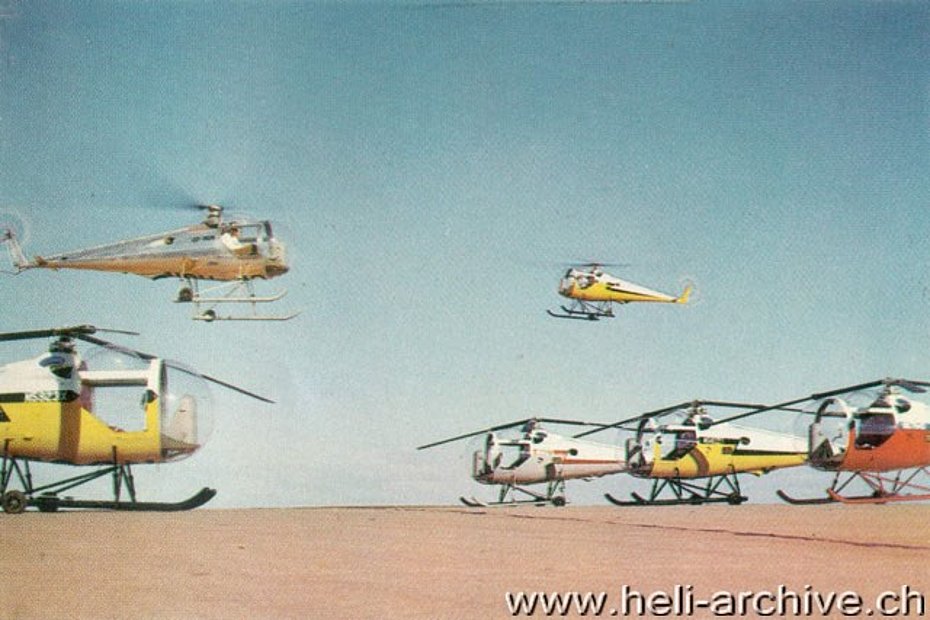
The news was of course welcomed with great enthusiasm by the staff who exploited the fact to promote the sales of the helicopter which was almost ready to enter in the commercial market. All the five units were however later returned to the manufacturer because judged to be too small to be of practical military use.
Finally on the 27th of April 1959, after the completion of the long certification program, the Brantly B-2 obtained the Type Certificate 2H2 from the Federal Aviation Agency (now Federal Aviation Administration). The production in series started that same year with a rate of one unit a week. Before the end of that year the company sold 10 units. On the 25th of May 1961 the company delivered its hundredth B-2.
In the meantime to boom the sales a new agency was opened in Elkhart (Indiana) while the idea to open new facilities for the production in England and Australia never materialized. The success of the small and agile B-2 prompted its builder to develop its direct successors the B-2A and then the B-2B, and the five-seater B-305 which had however a limited commercial success. Overall the company (which officially still exists even if it changed owner several times) produced about 500 helicopters sold all over the world but especially in the United States and in England. Its initial selling price was 19'950 US dollars, about 100'000 Sfr.
Nowadays several Brantly of the B-2 series are still flying and are mostly used by private pilots. This link shares information among Brantly helicopter fans: www.brantly.info
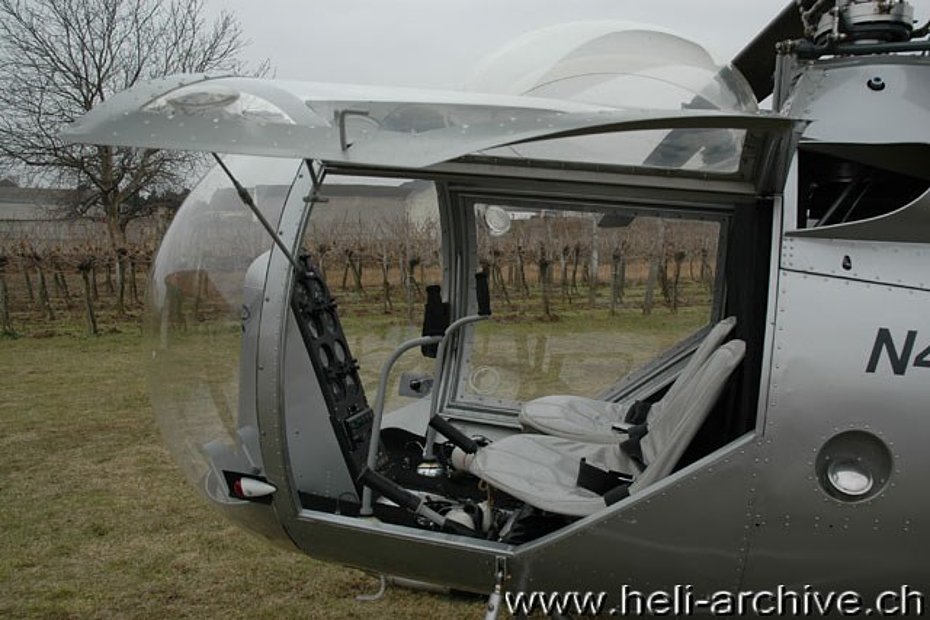
Technical description
The Brantly B-2 is a two-seater with adjustable seats placed side-by-side. The semi-monocoque fuselage is made of alloy stressed skin. The cabin with a cylindrical shape has a diameter of 1,19 m and is enclosed in the front part with a semi-spherical Plexiglas nose canopy. The cabin has two small bubbles also made of Plexiglas to give the passengers more headroom. For its silhouette it was nicknamed “The flying ice cream cone”. The access to the cabin is possible through two doors hinged at the top (dimensions 86 x 71 cm) which swing upward as in some sport cars. The flying controls are of conventional type, with the flying instruments accommodated in a central column.
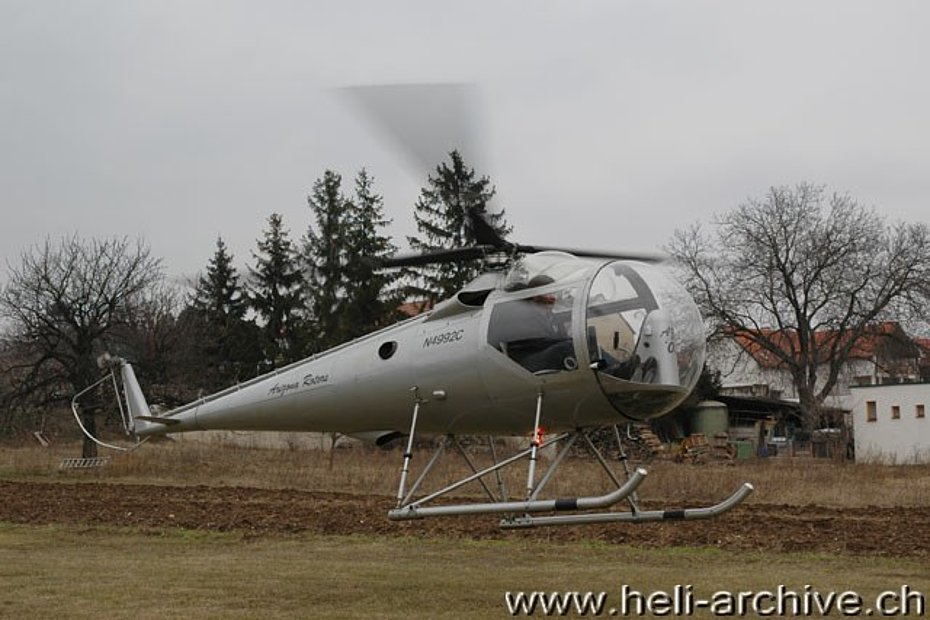
Between the two seats on the floor there are the levers of the carburettor air and the mixture control. Against the seat front there are the nose trim switch, the fuel shut-off and the manual rotor-brake controls. The latter is standard mounted for safety reasons (the blades clearance from the ground is rather reduced). The central fuselage section supports the cabin section, the main landing gear, the main rotor with the transmission, and the tail section. It houses the engine and its accessories, and the 117 litres fuel tank placed under the engine (the oil tank has a capacity of 8.55 litres). The fuel tank is separated from the engine compartment by a double floor the first of which is made of stainless steel. On the left of the fuselage there is a small baggage compartment with a volume of 17 litres where it is possible to load up to 22.7 kg. It is located in the front end of the tail section, just after the firewall. The skid landing gear is made of steel tubes. The landing shocks are absorbed by oleo shock struts. Ground handling is facilitated by wheels mounted on the skids. With no load in the cabin the B-2 balances on the ground wheels with the tail about 30 cm above the ground. In this position one person can, by applying pressure on the tail pylon assembly, easily move and guide the helicopter in any direction on a fairly smooth surface. A drive axle extends from the main gear to the two blades tail rotor though a 90° gear mounted in the rear of the fuselage. A metallic arc protects the tail rotor.
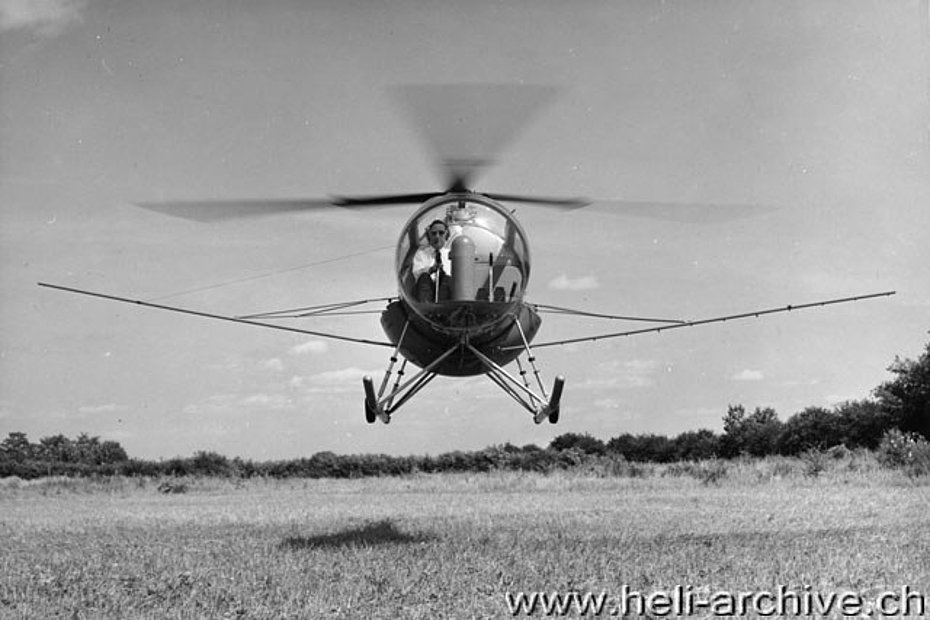
The most outstanding feature of the Brantly B-2 is the three-bladed main rotor which employs two sets of flapping hinges with lag hinges which are coincident with the outboard flapping hinges at approximately 40% of the blade radius. The inboard blade has a symmetrical section with a 29% thickness ratio and an effective chord of 22.4 cm. It is set at an angle of incidence which is 4 degrees greater than the outboard blade which has a modified NACA 0012 section with a 20.4 cm chord. The inboard flapping hinge is offset a distance of 6.78 cm from the hub, thereby providing a large hub moment with cyclic control movement giving excellent control response and a relatively large c.g. travel. This method of construction is designed to provide complete freedom of motion of the outboard blade sections which experience practically all of the aerodynamic forces of lift and drag. Thus, the outer blade sections, which are subjected to large oscillating forces, are allowed to assume positions more compatible with such forces without inducing bending moments across the outboard hinges. These hinges are supported by the steel tube members of the inboard blade sections which are designed to withstand the in plane bending moments without developing stresses above the fatigue strength of the material. The inboard ends of the steel support tubes are inter-connected from blade to blade by the triangular "tie-plates", so that oscillatory forces tend to counteract themselves within the rotor system without being introduced into the drive system or the controls and fuselage. From the s/n 54 the original main rotor blades were replaced with new ones made of polyurethane with bonded aluminium skin and extruded aluminium leading edge spar. Power is transmitted to the main rotor through a drive system consisting of a centrifugal clutch, a flexible coupling, overrunning clutch, and a planetary transmission with a 6.158 to 1 reduction ratio.
Unlike the prototypes the Brantlys produced in series were originally powered by a four cylinders Lycoming VO-360-A1A (much later –A1B or –B1A) with a maximum take-off power of 134/180 kW/cv. The engine cooling system utilizes the exhaust gases from the engine to create a pressure drop in the exhaust manifolds. These, in turn, draw cooling air through a passage formed by cylinder head baffles. Cooling air enters the engine compartment through air scoops located near the top of the engine compartment on each side of the fuselage. In forward flight the volume of cooling air is further increased by ram-effect. This unique system does the job without pulling horse power from the engine.
Performances
In standard atmospheric conditions, at its maximum takeoff weight of 726 kg, the helicopter has a cruising speed of 145-155 km/h, while the never exceed speed at sea level is 161 km/h. Above an altitude of 610 m/asl the speed must be reduced by 5 km/h each 305 m. Its service ceiling is about 2'830 meters. With a takeoff weight of 726 kg, and with a temperature of 15°C, the initial rate of climb is about 342 m/min. In the same flying conditions the helicopter hovers in ground effect up to 1’310 meters. With an average hourly fuel consumption of 40-45 litres, its range is 400-420 km, corresponding to 3h of flight endurance.
Dimensions, weights and payload
The Brantly B-2 main rotor has a diameter of 7.24 m (disc rotor area 41 m2), while its tail rotor has a diameter of 1.29 m (rotor disc area 1.30 m2). The fuselage has a length of 6.62 m. The height measured on the mast is just about 2,13 m. For this reason the boarding of a passenger while the rotor is turning is not particularly recommended. The standard empty weight of the aircraft is about 445 kg, while its MTOW is 726 kg. Deduced the standard weight of the pilot (77 kg) and with a fuel and oil reserve for one hour of flight (36 kg) the helicopter has a payload of about 168 kg.
Rotor and engine limitations
In flight the rotor rpm must be kept among 400 and 472 g/min for the blades of the series 248-100 and -101 respectively 500 for the ones of the series 248-40, -46, -53. In flight the engine range must be kept among 2'700 and 2'900 rpm. The max cylinders head temperature is 260°C.
Autorotation
To correctly execute an autorotation (simulating for example an engine or a tail rotor failure during a cruise flight) it is necessary to push down immediately the collective pitch lever and correct with the right foot pedal almost full down the yaw. After this it is necessary to reduce the speed to 88 km/h (55 mph). In normal flying conditions the pilot obtains the minimal rate of descent which is about 487 m/min. After the flare the pilot must level the aircraft and land within 4-5 seconds, which is in fact the time he disposes before the rotor rpm gauge decreases under the lower red line (400 rpm). The wide track (1.73 m) of the robust skid landing gear guarantees a sure contact with the terrain.
Accessories and installations
There were several accessories available for the B-2 such as the cabin soundproofing, engine hour meter, an aerodynamic horizontal stabilizer mounted behind the cabin (an invention of the test pilot Frank Erickson), ground handling wheel kit, dual controls, engine accessory group, navigation light kit, heater, fan, radio and exterior paint with contrasting stripe and registration. Its versatility was further increased by a light (16 kg) agricultural spray equipment consisting of a 150 litres tank made of moulded fibre glass. The form of the latter was adapted to fit and clamp to the fuselage directly under the engine compartment. Two aluminium tubing out-rigger booms (each with a 3.65 meters width) supported with a thin metallic cable were quickly rigged and sprayed a swath of 8.50 metres trough 24 anti-fouling plastic nozzles.
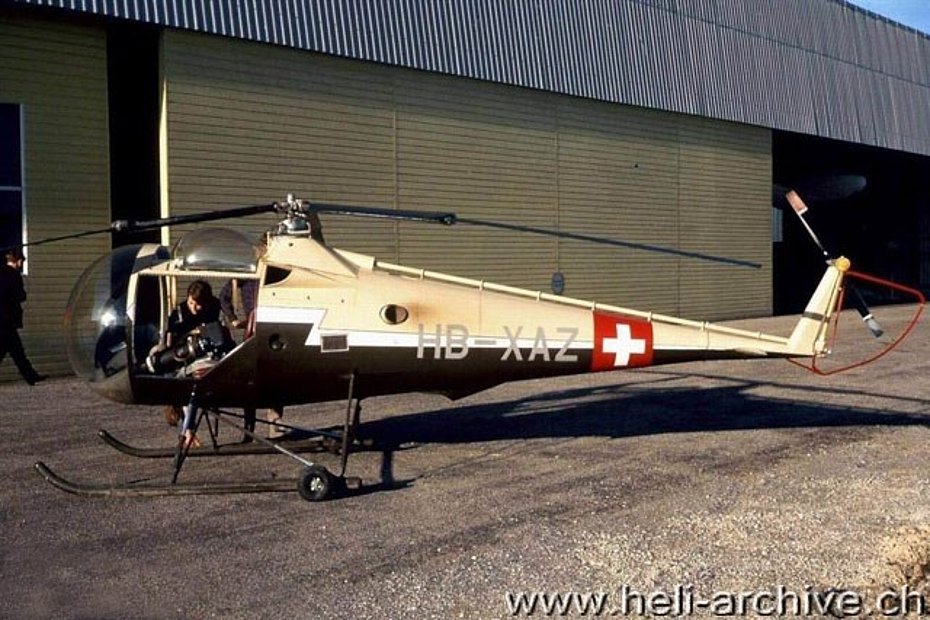
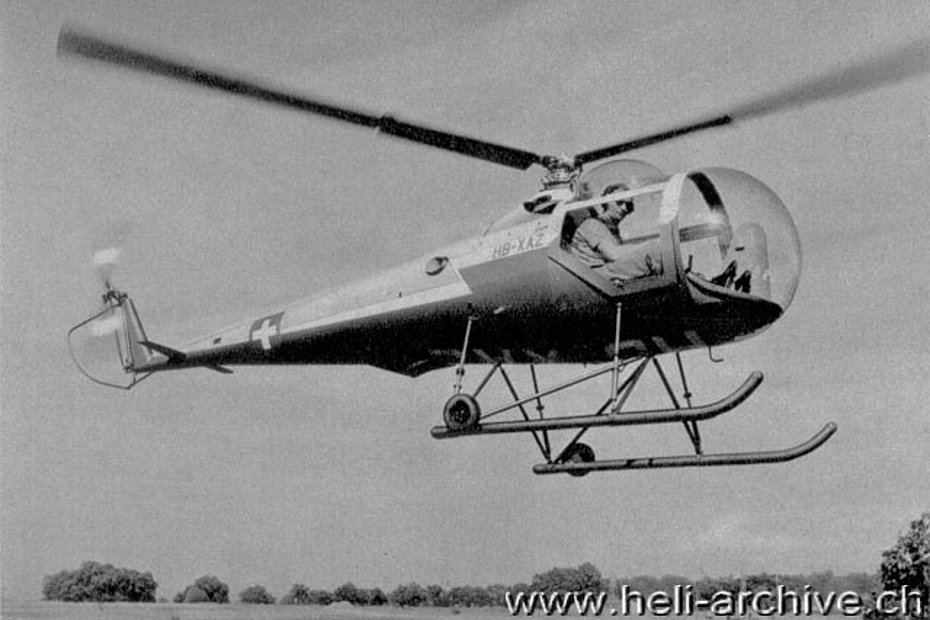
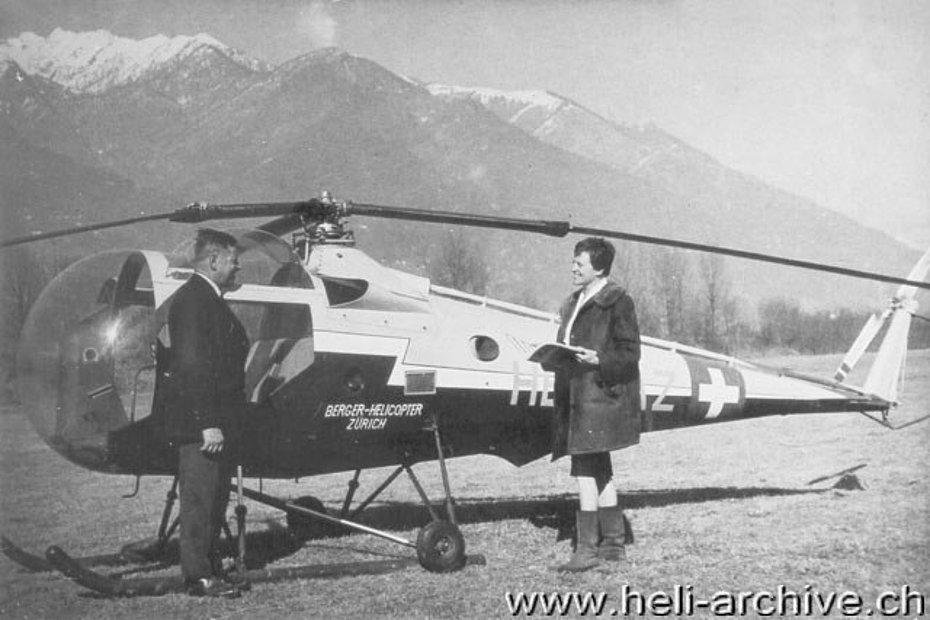
The Brantly B-2 in Switzerland
Two Brantly B-2 were registered in Switzerland, the first as HB-XAZ (s/n 93 – b/y 1961) and the second as HB-XBV (s/n 60 – b/y 1960). The HB-XAZ was at first imported by Aircraft G. Krautheim GmbH in Nuremberg (Germany) and was later sold in Switzerland to Hans Berger (who became the official dealer for the Brantly helicopters) for 99'307.— Sfr. The HB-XAZ was registered in Switzerland from the 24th of July 1961 until the 5th of August 1970 changing owner several times. In that period it was mainly used for photographic flights by Aircraft Zürich AG and Scania SA. On the 4th of March 1970 (the aircraft had logged alltogether 1'100 hours of flight) it was sold to Hans Berger for 15'000.— Sfr. The latter then transferred the helicopter in Ticino and later sold it again in Germany where it was registered D-HOBC.
Today it is exposed in the hangar of the private museum Flugausstellung L.+P. Junior in Hermeskeil (Germany).
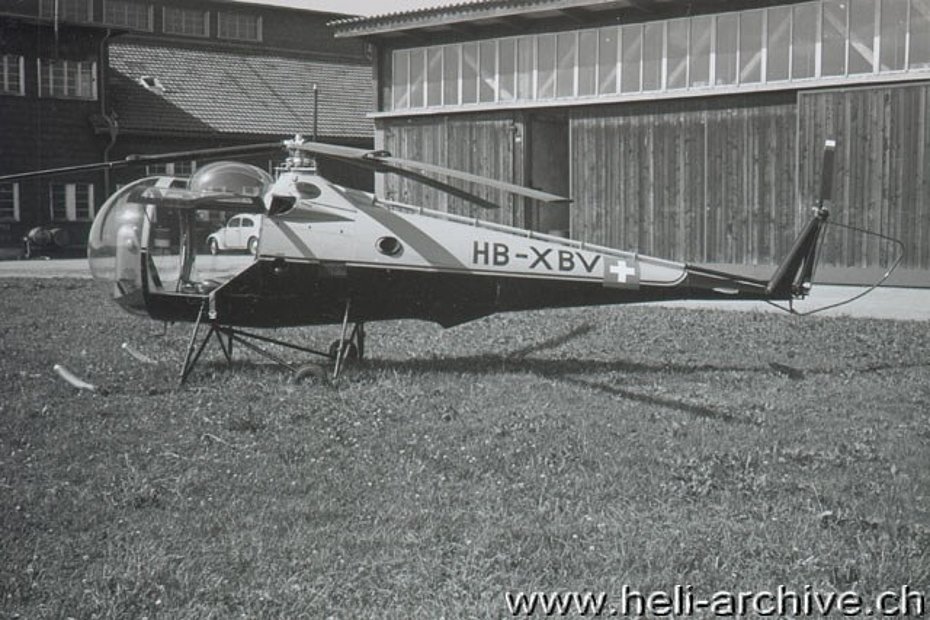
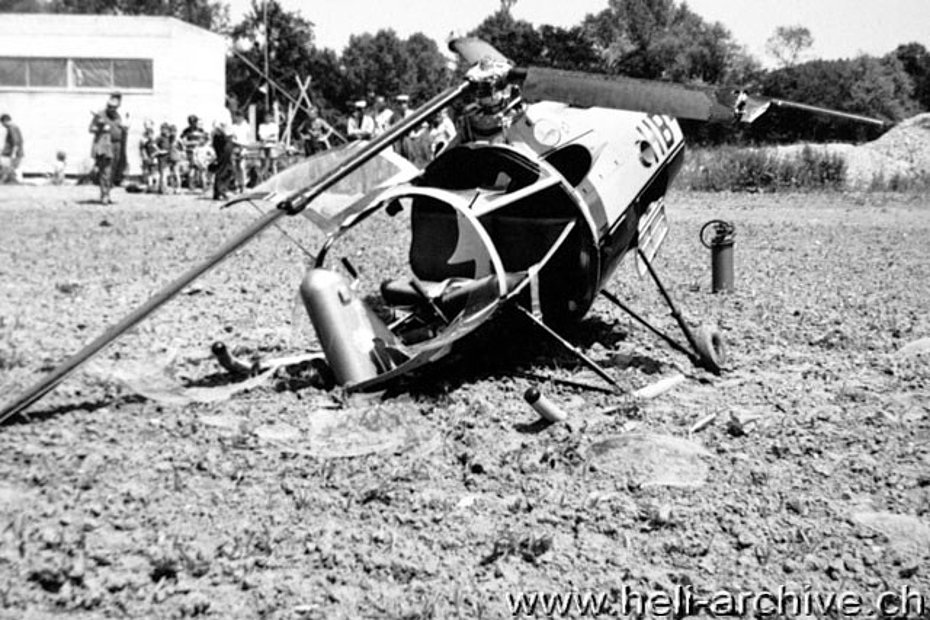
The second Brantly B-2 HB-XBV (ex D-HEBY) had, on the other hand, a short period of service in Switzerland. It was registered by Scania on the 28th of July 1964 and was also used for photographic flights. On the 24th of June 1965 while it was flying over Suhr/AG the aircraft’s engine had a sudden loss of power due to a mechanical failure (piston rod broke). Following the hard landing in a field the helicopter was damaged beyond repair, but fortunately both passengers left the cabin unhurt.
At the moment of the accident the HB-XBV had logged 931 hours of flight. The following 27th of July 1965 it was cancelled from the Swiss aircraft register.
The maintenance of both helicopters during their period of service in Switzerland was done by the mechanics of Pilatus, Air Base, and Heliswiss.
Berger reserved two other registrations (HB-XBA and HB-XBB) for two more Brantly B-2, but none of them was ever officially registered in Switzerland.
HAB 09/2010 (revised 12/2013)

